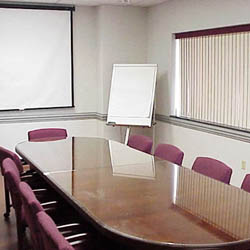
Using Delays to Enhance the Sound System
Sound travels through 70° F air at about 1.13 feet per millisecond.
In a large conference room using speech reinforcement, this delay causes the listener to perceive the direction of the talker from the ceiling loudspeakers and not directly from the talker.
This delay-related phenomena is one aspect of the Haas Effect or precedence effect.
The Haas Effect
When two loudspeakers are referenced with the same signal, the sound image direction is centered between the two loudspeakers.
As one of the loudspeakers is delayed up to 10 milliseconds, the sound image direction is shifted towards the non-delayed loudspeaker.
For the sound image to be restored to the center position, the delayed loudspeaker level must be increased by 10 dB. Increasing the level of the delayed loudspeaker also adds to the loudspeaker’s SPL.
If the delay is between 10 to 30 milliseconds, the delayed loudspeaker contributes a sense of liveliness but not direction. Increasing the delay by 50 milliseconds or more causes the listener to become aware of the delayed loudspeaker.
By utilizing the Haas Effect in a speech reinforcement system, the sound image direction is maintained from the talker and not the loudspeakers.
This is achieved by using delays in the sound system to align each microphone group to its reinforcement zone.
To determine the amount of delay required between each microphone group and its loudspeaker groups, measure the distance from the center talker of one microphone group to each center listener of the zones that the talkers microphone is reinforced.
Add to the measurement the distance from the listener to his closest loudspeaker. Using the measured distance for each zone, calculate the delay and add 10 milliseconds (See above formula).
Apply the calculated delay time to each zone for the microphone group. The number of delays required to perform this task is staggering for a large number of zones.
For example, a system with four zones may require three delays per zone (a delay for each microphone group within a zone) for a total of twelve delays!
Another method for aligning a microphone group to a zone is to use programmable delays for each zone and speech detection for each microphone group.
For this to work, the programmable delay must have fast recallable memories without producing audio artifacts during delay changes.
Each delay must have a memory setting stored for each microphone group. When speech is detected within a microphone group, all delays must recall their setting for that group.
Noise Masking
Providing a method for noise masking allows individuals to talk “off-record” without being easily heard by others in the room. This method is commonly used in courtroom applications.
Since noise masking may need to be selected in different areas, use a matrix mixer to select the masked zones.
Feedback Eliminator
Installing feedback eliminators at each loudspeaker group can help maintain system stability by reducing feedback.
The typical feedback eliminator performs this function using high-Q adaptable notch filters. When using feedback eliminators with echo cancellers, bypass the far-end audio around the feedback eliminator.
Download a copy of this article. (pdf)
Editors Note: This and other educational articles are available in the RaneNote Library, a subset of the Rane ProAudio Reference.

